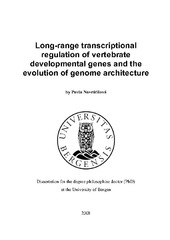Long-range transcriptional regulation of vertebrate developmental genes and the evolution of genome architecture
Doctoral thesis
Permanent lenke
https://hdl.handle.net/1956/3281Utgivelsesdato
2008-09-12Metadata
Vis full innførselSamlinger
Sammendrag
Despite the recent massive progress in production of vertebrate genome sequence data and large-scale efforts to completely annotate the human genome, we still have scant knowledge of the principles that built genomes in evolution, of genome architecture and its functional organization. This work uses bioinformatics and zebrafish transgenesis to explain a mechanism for the maintenance of long-range conserved synteny across vertebrate genomes and to analyze the arrangement of underlying gene regulation systems. Large mammal-teleost conserved chromosomal segments contain highly conserved non-coding elements (HCNEs), their target genes, as well as phylogenetically and functionally unrelated “bystander” genes. Target genes are developmental and transcriptional regulatory genes with complex, temporally and spatially regulated expression patterns. Bystander genes are not specifically under the control of the regulatory elements that drive the target genes and are usually expressed in different, less complex, patterns. Enhancer detection reporter insertions distal to zebrafish target genes recapitulate their expression patterns even if located inside or beyond bystander genes. We termed these chromosomal segments genomic regulatory blocks (GRBs). To demonstrate, that the regulatory domain of a developmental regulatory gene can extend into and beyond adjacent bystander gene transcriptional units and that these elements indeed regulate target genes, we tested the function of HCNEs around genes encoding transcription factors, PAX6, SOX3 and SOX11 in both human and zebrafish genomes. Comparing our results with those obtained using mouse, we establish that human elements can be tested reliably in zebrafish. Testing the elements form SOX11 loci further revealed subfunctionalization after genome duplication and functional turnover as evolutionary processes on the gene regulation. The genome features confirmed by this work were also applied to provide an advance in understanding human mutations causing or predisposing towards genetic diseases. These mutations are frequently associated to the incorrect gene(s) coding region instead of taking the regulatory mutation in distant regulatory elements of another possible causative gene into account. We could demonstrate using our approach that the genes linked to diabetes by genome wide association study contain in their introns HCNEs regulating different, more distant gene functionally more probably related to the diabetes phenotype.
Består av
Paper I: Genome research, Genomic regulatory blocks encompass multiple neighboring genes and maintain conserved synteny in vertebrates, pp. 545-555, 2007. Copyright Cold Spring Harbor Laboratory Press. http://dx.doi.org/10.1101/gr.6086307 This is an open access article distributed under the Creative Commons Attribution License, which permits unrestricted use, distribution, and reproduction in any medium, provided the original work is properly cited.Paper 2: Navratilova P, Fredman D, Lenhard B, and Becker TS: Systematic mapping of cis-regulatory activity in megabase regions around human transcription factor genes SOX3 and PAX6. Submitted. Fulltext not available
Paper 3: Navratilova P, Fredman D, Lenhard B, Becker TS: Regulatory divergence of the duplicated chromosomal loci sox11a/b by subpartitioning and evolution of enhancers in zebrafish. Manuscript. Fulltext not available.
Paper 4: Lenhard B, Ragvin A, Fredman D, Navratilova P, Drivenes Ø, Engström PG, de la Calle Mustienes E, Gómez Skarmeta JL, Tavares MJ, Casares F, Molven A, Njølstad PR, and Becker TS: Type 2 diabetes susceptibility variants map within long-range regulatory domains of transcription factor genes. Submitted. Fulltext not available
